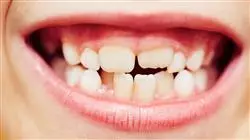University certificate
The world's largest faculty of nursing”
Introduction to the Program
This program will generate a sense of security in the performance of daily praxis, which will help you grow personally and professionally"

Nutrition is essential for people's survival, but sometimes certain diseases lead to problems with nutrition. Sometimes these can be caused by the person's own anatomy or generated through bad habits, as is the case with certain orofacial disorders. In these cases, nurses play a fundamental role, since many of the consultations of these professionals are derived from this type of disorders.
Therefore, during this training program, professionals will learn about the nutritional needs of autistic people and people with cerebral palsy, diseases that are associated with nutritional problems and that depend on nursing professionals to improve their quality of life.
Thus, there is a wide professional demand for training to acquire the necessary competencies to enable nurses to provide a comprehensive and complete educational, health and clinical response. In addition, it is necessary the collaboration and integration in the nursing teams of professionals from other health fields to complete the group in an interdisciplinary way. Both nurses and clinicians will benefit from training actions of this caliber, which integrate the vision of clinical speech therapy and the needs of an effective response demanded by nursing.
This Postgraduate diploma in Orofacial Disorders and Feeding in ASD and CP for Nurses responds to this demand for continuing education of health agents, and is aimed primarily at nursing professionals. With this training course, the nurse will acquire skills to manage speech disorders or disorders of a logopedic nature in different work contexts. In addition, these studies can facilitate access to employment in this field, due to the high demand for this type of professional, whether in the health, clinical or educational fields.
You must continue your training throughout your employment to provide the best care for your patients"
This Postgraduate diploma in Orofacial Disorders and Feeding in ASD and CP for Nurses contains the most complete and up to date educational program on the market. The most important characteristics of the Postgraduate Diploma are:
- The development of a large number of case studies presented by experts in orofacial and feeding disorders in ASD and ICH. The graphic, schematic, and eminently practical contents with which they are created provide scientific and practical information on the disciplines that are essential for professional practice
- News on the use of orofacial and feeding disorders in ASD and CP
- Practical exercises where the self-assessment process can be carried out to improve learning
- Algorithm-based interactive learning system for decision-making in the situations that are presented to the student
- Special emphasis on evidence-based methodologies in orofacial and feeding disorders in ASD and CP
- Theoretical lessons, questions to the expert, discussion forums on controversial issues and individual reflection papers
- Content that is accessible from any fixed or portable device with an Internet connection
Study this Postgraduate diploma with TECH in a comfortable way as it is 100% online and become a first class nurse"
Its teaching staff includes professionals belonging to the field of orofacial disorders and feeding in ASD and CP who bring to this training the experience of their work, as well as recognized specialists belonging to reference societies and prestigious universities.
The multimedia content developed with the latest educational technology will provide the professional with situated and contextual learning, i.e., a simulated environment that will provide an immersive training program to train in real situations.
The design of this program is based on problem-based learning, by means of which the professional must try to solve the different professional practice situations that arise throughout the course. For this purpose, the professional will be assisted by an innovative interactive video system developed by recognized experts in the field of orofacial and feeding disorders in ASD and CP, and with extensive teaching experience.
A unique, key, and decisive Training experience to boost your professional development"

Acquire a complete training in the field of orofacial disorders thanks to a teaching program with innovative methodologies and the main novelties in the market"
Why study at TECH?
TECH is the world’s largest online university. With an impressive catalog of more than 14,000 university programs available in 11 languages, it is positioned as a leader in employability, with a 99% job placement rate. In addition, it relies on an enormous faculty of more than 6,000 professors of the highest international renown.

Study at the world's largest online university and guarantee your professional success. The future starts at TECH”
The world’s best online university according to FORBES
The prestigious Forbes magazine, specialized in business and finance, has highlighted TECH as “the world's best online university” This is what they have recently stated in an article in their digital edition in which they echo the success story of this institution, “thanks to the academic offer it provides, the selection of its teaching staff, and an innovative learning method aimed at educating the professionals of the future”
A revolutionary study method, a cutting-edge faculty and a practical focus: the key to TECH's success.
The most complete study plans on the university scene
TECH offers the most complete study plans on the university scene, with syllabuses that cover fundamental concepts and, at the same time, the main scientific advances in their specific scientific areas. In addition, these programs are continuously being updated to guarantee students the academic vanguard and the most in-demand professional skills. In this way, the university's qualifications provide its graduates with a significant advantage to propel their careers to success.
TECH offers the most comprehensive and intensive study plans on the current university scene.
A world-class teaching staff
TECH's teaching staff is made up of more than 6,000 professors with the highest international recognition. Professors, researchers and top executives of multinational companies, including Isaiah Covington, performance coach of the Boston Celtics; Magda Romanska, principal investigator at Harvard MetaLAB; Ignacio Wistumba, chairman of the department of translational molecular pathology at MD Anderson Cancer Center; and D.W. Pine, creative director of TIME magazine, among others.
Internationally renowned experts, specialized in different branches of Health, Technology, Communication and Business, form part of the TECH faculty.
A unique learning method
TECH is the first university to use Relearning in all its programs. It is the best online learning methodology, accredited with international teaching quality certifications, provided by prestigious educational agencies. In addition, this disruptive educational model is complemented with the “Case Method”, thereby setting up a unique online teaching strategy. Innovative teaching resources are also implemented, including detailed videos, infographics and interactive summaries.
TECH combines Relearning and the Case Method in all its university programs to guarantee excellent theoretical and practical learning, studying whenever and wherever you want.
The world's largest online university
TECH is the world’s largest online university. We are the largest educational institution, with the best and widest online educational catalog, one hundred percent online and covering the vast majority of areas of knowledge. We offer a large selection of our own degrees and accredited online undergraduate and postgraduate degrees. In total, more than 14,000 university degrees, in eleven different languages, make us the largest educational largest in the world.
TECH has the world's most extensive catalog of academic and official programs, available in more than 11 languages.
Google Premier Partner
The American technology giant has awarded TECH the Google Google Premier Partner badge. This award, which is only available to 3% of the world's companies, highlights the efficient, flexible and tailored experience that this university provides to students. The recognition as a Google Premier Partner not only accredits the maximum rigor, performance and investment in TECH's digital infrastructures, but also places this university as one of the world's leading technology companies.
Google has positioned TECH in the top 3% of the world's most important technology companies by awarding it its Google Premier Partner badge.
The official online university of the NBA
TECH is the official online university of the NBA. Thanks to our agreement with the biggest league in basketball, we offer our students exclusive university programs, as well as a wide variety of educational resources focused on the business of the league and other areas of the sports industry. Each program is made up of a uniquely designed syllabus and features exceptional guest hosts: professionals with a distinguished sports background who will offer their expertise on the most relevant topics.
TECH has been selected by the NBA, the world's top basketball league, as its official online university.
The top-rated university by its students
Students have positioned TECH as the world's top-rated university on the main review websites, with a highest rating of 4.9 out of 5, obtained from more than 1,000 reviews. These results consolidate TECH as the benchmark university institution at an international level, reflecting the excellence and positive impact of its educational model.” reflecting the excellence and positive impact of its educational model.”
TECH is the world’s top-rated university by its students.
Leaders in employability
TECH has managed to become the leading university in employability. 99% of its students obtain jobs in the academic field they have studied, within one year of completing any of the university's programs. A similar number achieve immediate career enhancement. All this thanks to a study methodology that bases its effectiveness on the acquisition of practical skills, which are absolutely necessary for professional development.
99% of TECH graduates find a job within a year of completing their studies.
Postgraduate Diploma in Orofacial Disorders and Feeding in ASD and CP for Nursing
At TECH Global University, we present our Postgraduate Diploma program in Orofacial and Feeding Disorders in ASD (Autism Spectrum Disorder) and CP (Infantile Cerebral Palsy) designed especially for Nursing professionals. If you are interested in expanding your knowledge and skills in the approach to orofacial and feeding disorders in people with ASD and CP, this program is ideal for you! Our program is taught in online classes, which gives you the flexibility to study from anywhere and adapt your learning to your schedule. At TECH Global University, we are committed to providing you with the best educational experience with the most advanced technological tools and resources. In this program, you will immerse yourself in the study of orofacial and feeding disorders present in people with ASD and PD. You will learn about the particularities of these disorders, their causes, assessment and diagnosis, as well as the most effective therapeutic and intervention strategies.
Learn from the best experts in Nursing.
Our team of highly qualified faculty will guide you through each step of the program, providing you with the theoretical and practical knowledge necessary to understand and comprehensively address orofacial and feeding disorders in individuals with ASD and CPI. In addition, you will have access to online educational resources, case studies, multimedia materials and interactive tools that will enrich your learning and help you apply the knowledge acquired in real patient care situations. At the end of the program, you will be prepared to provide quality and specialized care to individuals with ASD and PD who present with orofacial and feeding disorders. You will be able to evaluate, design and implement therapeutic interventions that promote healthy eating and proper orofacial development, thus improving the quality of life of your patients. Don't miss the opportunity to specialize in a field in growing demand and make a significant contribution to the well-being and development of people with ASD and PD. Join TECH today.







